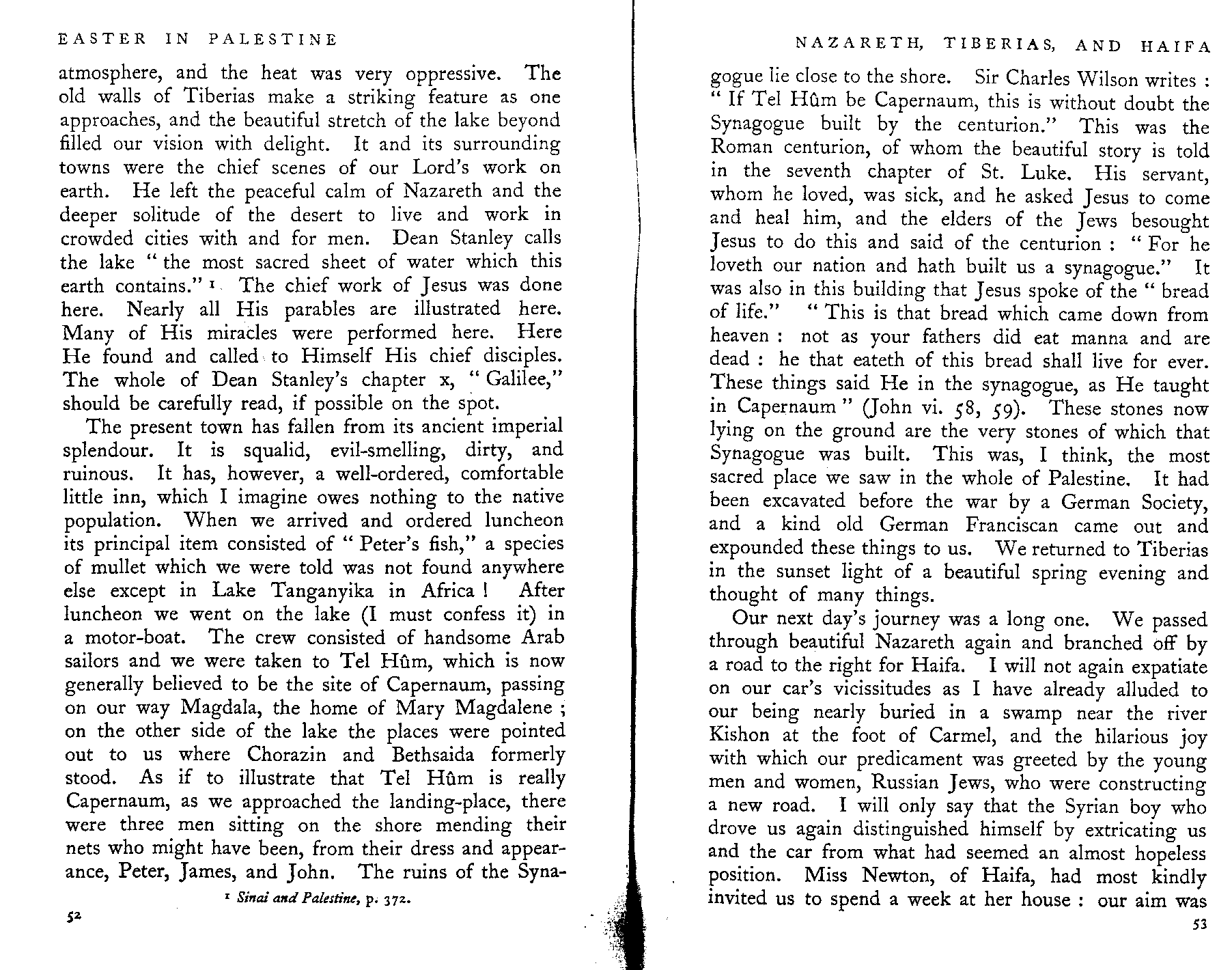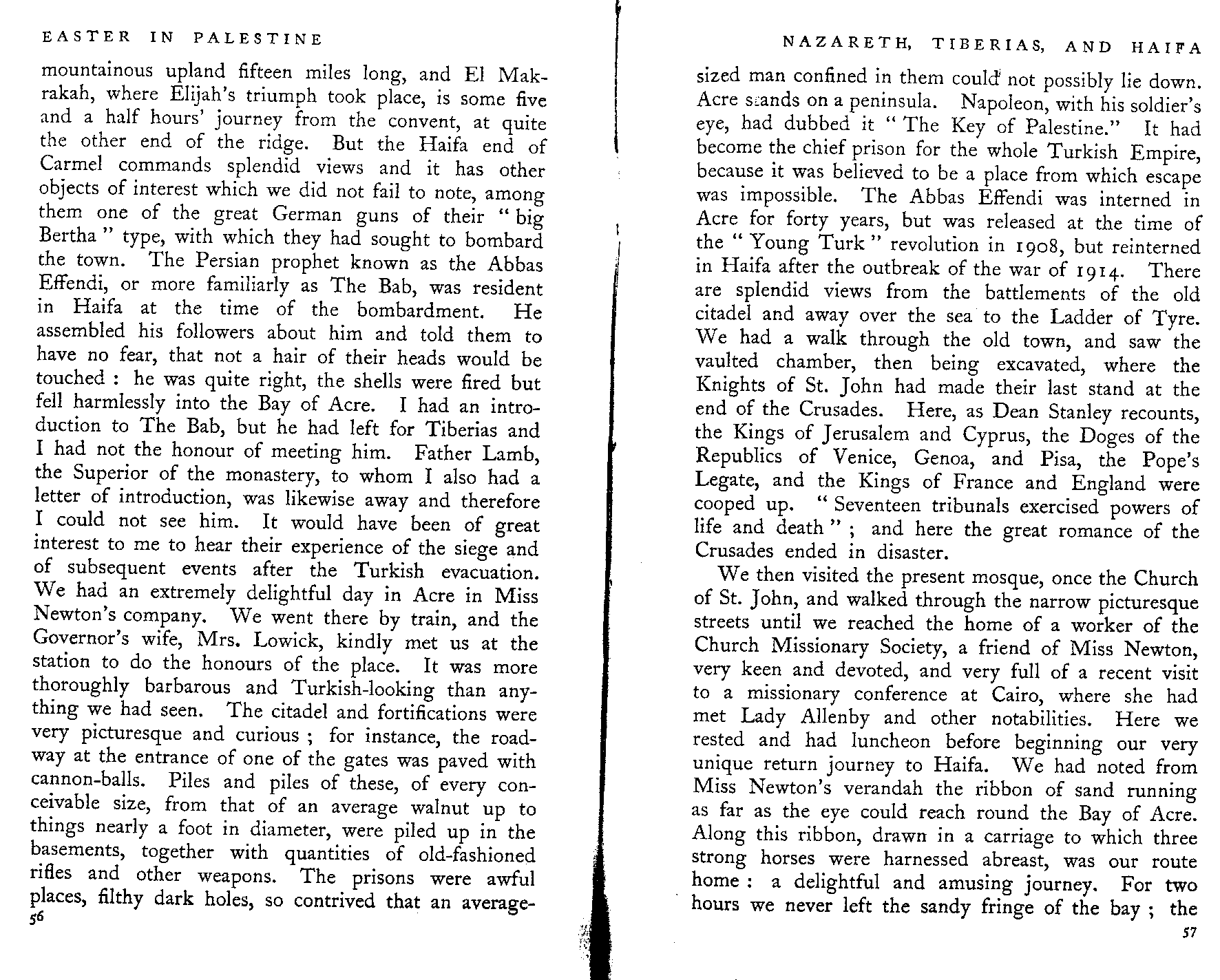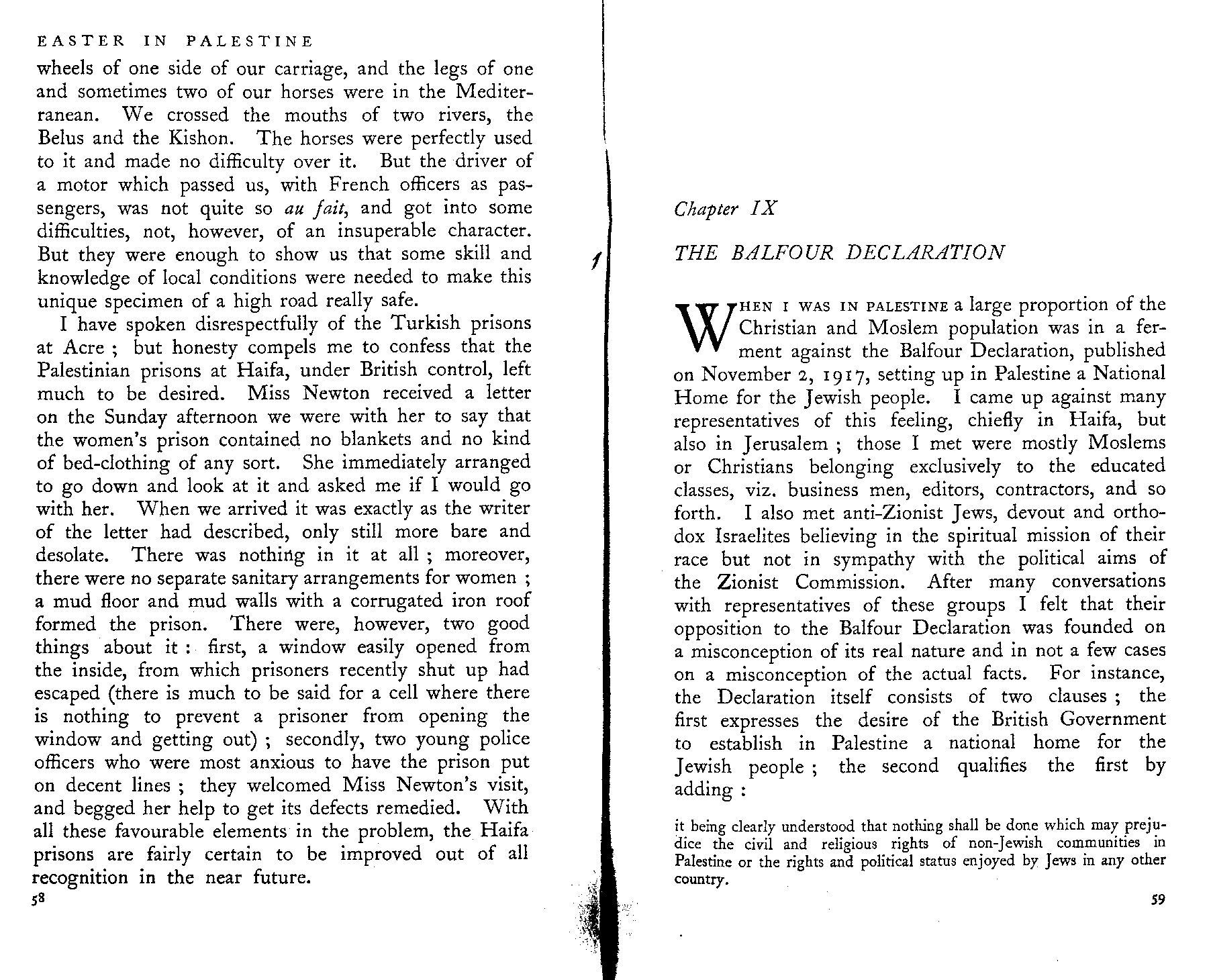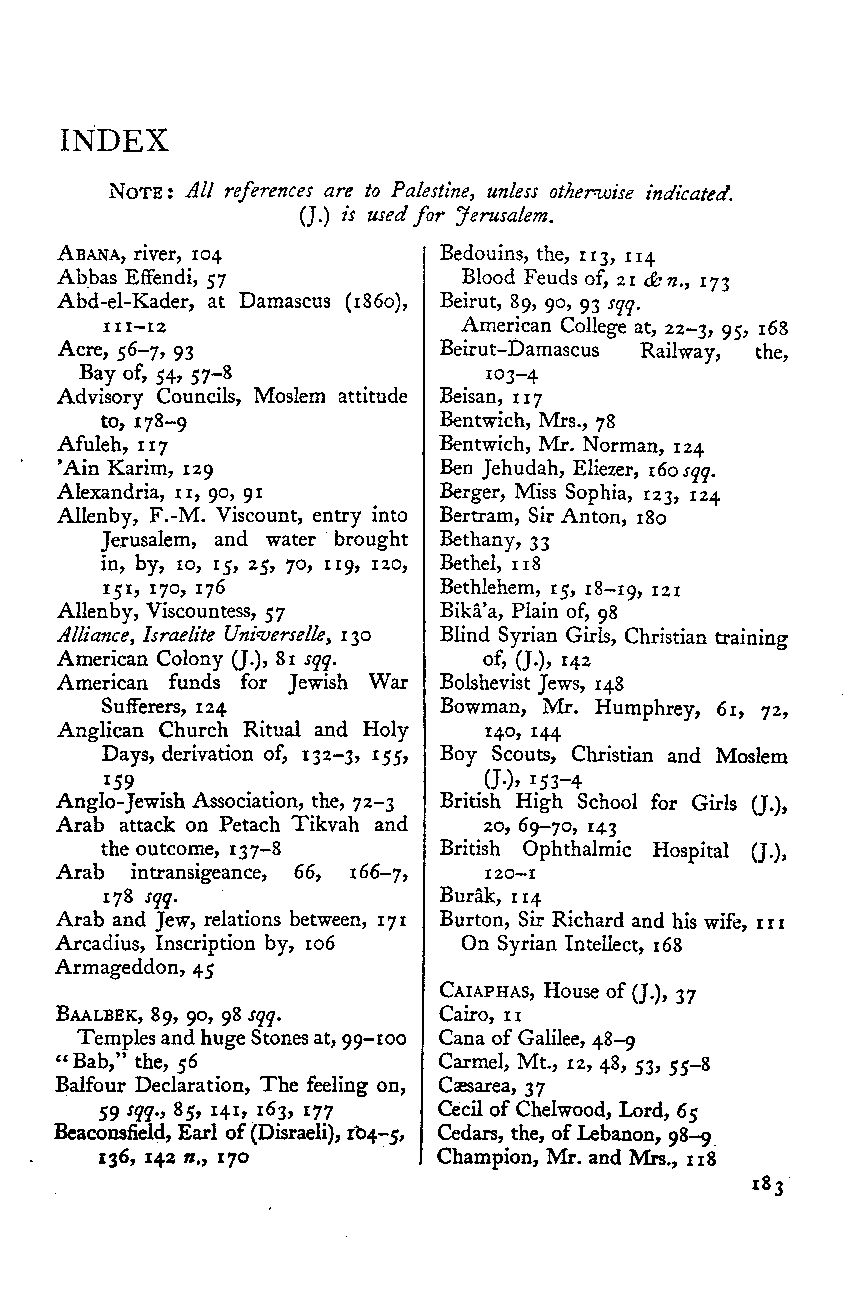
|
|
Abstract: Background of Tiberias, Akka, and Haifa, with passing mentions of The Bab and Abdu'l-Bahá. |
1. Text
[page 52]... The old walls of Tiberias make a striking feature as one approaches, and the beautiful stretch of the lake beyond filled our vision with delight. It and its surrounding towns were the chief scenes of our Lord's work on earth. He left the peaceful calm of Nazareth and the deeper solitude of the desert to live and work in crowded cities with and for men. Dean Stanley calls the lake "the most sacred sheet of water which this earth contains." [Footnote 1: Sinai and Palestine, p. 372.] The chief work of Jesus was done here. Nearly all His parables are illustrated here. Many of His miracles were performed here. Here He found and called to Himself His chief disciples. The whole of Dean Stanley's chapter x, "Galilee," should be carefully read, if possible on the spot.
The present town has fallen from its ancient imperial splendour. It is squalid, evil-smelling, dirty, and ruinous. It has, however, a well-ordered, comfortable little inn, which I imagine owes nothing to the native population. When we arrived and ordered luncheon its principal item consisted of "Peter's fish," a species of mullet which we were told was not found anywhere else except in Lake Tanganyika in Africa! After luncheon we went on the lake (I must confess it) in a motor-boat. The crew consisted of handsome Arab sailors and we were taken to Tel Hum, which is now generally believed to be the site of Capernaum, passing on our way Magdala, the home of Mary Magdalene; on the other side of the lake the places were pointed out to us where Chorazin and Bethsaida formerly stood. As if to illustrate that Tel Hum is really Capernaum, as we approached the landing-place, there were three men sitting on the shore mending their nets who might have been, from their dress and appearance, Peter, James, and John. The ruins of the Synagogue
[53]
lie close to the shore. Sir Charles Wilson writes: "If Tel Hum be Capernaum, this is without doubt the Synagogue built by the centurion." This was the Roman centurion, of whom the beautiful story is told in the seventh chapter of St. Luke. His servant, whom he loved, was sick, and he asked Jesus to come and heal him, and the elders of the Jews besought Jesus to do this and said of the centurion: "For he loveth our nation and hath built us a synagogue." It was also in this building that Jesus spoke of the "bread of life." "This is that bread which came down from heaven: not as your fathers did eat manna and are dead: he that eateth of this bread shall live for ever. These things said He in the synagogue, as He taught in Capernaum" (John vi. 58, 59). These stones now lying on the ground are the very stones of which that Synagogue was built. This was, I think, the most sacred place we saw in the whole of Palestine. It had been excavated before the war by a German Society, and a kind old German Franciscan came out and expounded these things to us. We returned to Tiberias in the sunset light of a beautiful spring evening and thought of many things.
Our next day's journey was a long one. We passed through beautiful Nazareth again and branched off by a road to the right for Haifa. I will not again expatiate on our car's vicissitudes as I have already alluded to our being nearly buried in a swamp near the river Kishon at the foot of Carmel, and the hilarious joy with which our predicament was greeted by the young men and women, Russian Jews, who were constructing a new road. I will only say that the Syrian boy who drove us again distinguished himself by extricating us and the car from what had seemed an almost hopeless position. Miss Newton, of Haifa, had most kindly invited us to spend a week at her house: our aim was
[54]
therefore a double one: to deposit my sister and myself at Miss Newton's house, on the slopes of Carmel, by four o'clock, and our friend at the railway station in time for her to take up quarters (which had been already engaged for her) in the train which would leave early the next morning en route for Lud and Kantara on her way home. This seems to be an established practice in Palestine, and a very sensible one. When a train leaves a station, say at four a.m., passengers are, if possible, allowed on board the previous evening, so that they can practically secure a night's rest before their actual start. Some years ago, I had very considerable difficulty, when leaving Port Elizabeth in South Africa in the small hours of the morning, in getting permission from the railway authorities to take up my abode in the train overnight. But that was twenty years ago, and what was then an unwelcome innovation had now become an established practice.
On arriving at Miss Newton's house, we were disappointed to find that she was laid up by an attack of malaria which had been threatening while she was with us in Jerusalem. But we received a very warm welcome all the same, both from herself and her charming young secretary, Miss Rhoda Power. The house is a very lovely one, and in a most beautiful situation, looking out towards the Bay of Acre or Akka, as it is called here, with the Ladder of Tyre beyond it. The principal living room, high up in the house, is very large and not much encumbered by furniture: everything in it was either useful or beautiful, and sometimes both. Its air of spaciousness is increased by its opening on an almost equally large verandah; verandah and room together, could easily accommodate a public meeting of several hundred people. The whole house was commandeered during the war and used as the headquarters of the Turkish
[55]
Army in Haifa, and afterwards became a Red Cross Hospital. The Turks before they left it rifled it of everything it contained.
We were soon enabled to appreciate the almost unique position Miss Newton holds in Palestine. She has lived there for twenty-five years, speaks Arabic like a native, has worked with and for the people of the land, irrespective of race or creed, for the whole of her adult life. She has been the practical exemplar of the Christian life, living for others, and helping all who need help. She and her sister (now dead), we learned, though not from her, had established and financed an English hospital at Jaffa for twenty-nine years, and had fought with and baffled a terrible outbreak of cholera at Lud in 1902-3. She understands and loves the people, and they have unbounded confidence in and affection for her. She acts as a sort of poor man's lawyer, and the lower part of her house at Haifa is really almost a lawyer's office combined with a C.O.S. bureau. People with grievances, either physical, moral, or political, real or imaginary, come and talk to her about them. It was a very interesting experience to be with her and to see the constant stream of people who were passing through her house to seek her advice.
Rainy weather returned while we were Miss Newton's guests, and we were not able to carry out some of the pleasant excursions she had planned for us. But we read Sir George Adam Smith's Historical Geography of Palestine when it rained, and walked or drove on Mount Carmel when it was fine; we saw the famous monastery, and what we liked even better, tulips and irises in the grass besides red asphodel and the darker pink cyclamen growing in the grass as thick as buttercups in an English meadow in May. We did not get to the place which is connected with Elijah's victory over the priests of Baal. For Carmel is not so much a mountain as a
[56]
mountainous upland fifteen miles long, and El Makrakah, where Elijah's triumph took place, is some five and a half hours' journey from the convent, at quite the other end of the ridge. But the Haifa end of Carmel commands splendid views and it has other objects of interest which we did not fail to note, among them one of the great German guns of their "big Bertha" type, with which they had sought to bombard the town. The Persian prophet known as the Abbas Effendi, or more familiarly as The Bab, was resident in Haifa at the time of the bombardment. He assembled his followers about him and told them to have no fear, that not a hair of their heads would be touched: he was quite right, the shells were fired but fell harmlessly into the Bay of Acre. [See editor's note] I had an introduction to The Bab, but he had left for Tiberias and I had not the honour of meeting him. Father Lamb, the Superior of the monastery, to whom I also had a letter of introduction, was likewise away and therefore I could not see him. [See note] It would have been of great interest to me to hear their experience of the siege and of subsequent events after the Turkish evacuation. We had an extremely delightful day in Acre in Miss Newton's company. We went there by train, and the Governor's wife, Mrs. Lowick, kindly met us at the station to do the honours of the place. It was more thoroughly barbarous and Turkish-looking than anything we had seen. The citadel and fortifications were very picturesque and curious; for instance, the roadway at the entrance of one of the gates was paved with cannon-balls. Piles and piles of these, of every conceivable size, from that of an average walnut up to things nearly a foot in diameter, were piled up in the basements, together with quantities of old-fashioned rifles and other weapons. The prisons were awful places, filthy dark holes, so contrived that an average-sized
[57]
man confined in them could not possibly lie down. Acre stands on a peninsula. Napoleon, with his soldier's eye, had dubbed it "The Key of Palestine." It had become the chief prison for the whole Turkish Empire, because it was believed to be a place from which escape was impossible. The Abbas Effendi was interned in Acre for forty years, but was released at the time of the "Young Turk" revolution in 1908, but reinterned in Haifa after the outbreak of the war of 1914. There are splendid views from the battlements of the old citadel and away over the sea to the Ladder of Tyre. We had a walk through the old town, and saw the vaulted chamber, then being excavated, where the Knights of St. John had made their last stand at the end of the Crusades. Here, as Dean Stanley recounts, the Kings of Jerusalem and Cyprus, the Doges of the Republics of Venice, Genoa, and Pisa, the Pope's Legate, and the Kings of France and England were cooped up. "Seventeen tribunals exercised powers of life and death"; and here the great romance of the Crusades ended in disaster.
We then visited the present mosque, once the Church of St. John, and walked through the narrow picturesque streets until we reached the home of a worker of the Church Missionary Society, a friend of Miss Newton, very keen and devoted, and very full of a recent visit to a missionary conference at Cairo, where she had met Lady Allenby and other notabilities. Here we rested and had luncheon before beginning our very unique return journey to Haifa. We had noted from Miss Newton's verandah the ribbon of sand running as far as the eye could reach round the Bay of Acre. Along this ribbon, drawn in a carriage to which three strong horses were harnessed abreast, was our route home: a delightful and amusing journey. For two hours we never left the sandy fringe of the bay; the
[58]
wheels of one side of our carriage, and the legs of one and sometimes two of our horses were in the Mediterranean. We crossed the mouths of two rivers, the Belus and the Kishon. The horses were perfectly used to it and made no difficulty over it. But the driver of a motor which passed us, with French officers as passengers, was not quite so au fait, and got into some difficulties, not, however, of an insuperable character. But they were enough to show us that some skill and knowledge of local conditions were needed to make this unique specimen of a high road really safe.
I have spoken disrespectfully of the Turkish prisons at Acre; but honesty compels me to confess that the Palestinian prisons at Haifa, under British control, left much to be desired. Miss Newton received a letter on the Sunday afternoon we were with her to say that the women's prison contained no blankets and no kind of bed-clothing of any sort. She immediately arranged to go down and look at it and asked me if I would go with her. When we arrived it was exactly as the writer of the letter had described, only still more bare and desolate. There was nothing in it at all; moreover, there were no separate sanitary arrangements for women; a mud floor and mud walls with a corrugated iron roof formed the prison. There were, however, two good things about it: first, a window easily opened from the inside, from which prisoners recently shut up had escaped (there is much to be said for a cell where there is nothing to prevent a prisoner from opening the window and getting out); secondly, two young police officers who were most anxious to have the prison put on decent lines; they welcomed Miss Newton's visit, and begged her help to get its defects remedied. With all these favourable elements in the problem, the Haifa prisons are fairly certain to be improved out of all recognition in the near future.
- These sentences contain two errors. The Bab founded the Babi Faith in 1844, while Abbas Effendi was the son of Bahá'u'lláh, founder of the Bahá'í Faith in 1863. The Bab was executed in Iran, not Akka. (-J.W., 2014)
- Shee "had an introduction" to Abdu'l-Bahá (Abbas Effendi), not The Bab. (-J.W., 2014)
2. Image scans (click image for larger version)

|
|





